National Rail Museum, New Delhi

The National Rail Museum, in Chanakyapuri, New Delhi, displays exhibits on the history of Indian railways.
The National Rail Museum opened on February 1, 1977 and spans over 10 acres (40,000 m2). The sheer size of the museum makes it difficult to get around on foot, therefore a mini train is offered to visitors for tours around the site on its days of operation.
The National Rail Museum is open every day except Mondays and national holidays. In addition to its vast galleries, the museum also contains simulators for diesel, steam engines, and coaches.
History
The National Rail Museum was first proposed in 1962, but it began to take concrete shape in 1970 under the advising of rail enthusiast Michael Graham Satow. On October 7, 1971, the foundation stone was laid by the then President V. V. Giri at the present site in Chanakyapuri, New Delhi. The museum was inaugurated as the Rail Transport Museum in 1977 by Kamalapati Tripathi, the Minister for Railways. Its name was changed to the National Rail Museum in 1995.[1]
The Rail Museum was intended to be part of a larger museum that covered the history of railways, roadways, airways and waterways in India, and eventually became a full-fledged National Rail Museum in 1995.[2]
Main exhibits
- Patiala State Monorail Trainways: This unique steam monorail was built in 1907. The train is based on the Ewing System, and connected Bassi with Sirhind-Fategarh (approximately 6 miles). The unique train system consists of a single-rail track, hence the name monorail. The load-carrying wheel runs on the single track while large iron wheels on either side keep the train upright. The train was built by Orenstein & Koppel of Berlin and ran until October 1927. The monorail line was closed in 1927 with the advent of better and faster modes of transportation such as cars and buses. The engine and the chief engineer's inspection car escaped being sold for scrap and remained in the railway's own scrapyard. In 1962, the remains of Patiala State Monorail Trainways were discovered by railroad historian Mike Satow. Thereafter, one engine was restored to full working order by the Northern Railway Workshops in Amritsar. The Chief Engineer's private inspection car was also reconstructed on an old underframe. The two are now in running condition and are on display at the Museum.[3]
- Fairy Queen: the world's oldest working steam locomotive in operational service.
- Fire Engine: Morris Fire Engine was built by the famous fire engineers John Morris and Sons Ltd of Salford, Lancashire in 1914. Only two Morris-Belsize fire-engines are known to exist in the world today. Apart from the one at the National Rail Museum, a 1912 model is preserved by the Enfield and District Veteran Vehicle. The fire engine preserved at the Enfield and District Veteran Vehicle, Whitewebbs Museum of Transport, Clay Hill, London, has been converted to use pneumatic tires by Dennis Bros. Thus, the fire engine at National Rail Museum is the only one left in the world running on solid rubber tires.
- Saloon of The Prince of Wales: This saloon was built for the Prince of Wales (later King Edward VII) for his visit to India.
- Saloon of The Maharaja of Indore: This was the saloon of Holkar Maharaja of Indore.
- Saloon of The Maharaja of Mysore: This was the personal saloon of the Maharaja of Mysore. The saloon is designed using teak, gold, ivory, and other materials.
- Electric locomotive 4502 Sir Leslie Wilson: This 1928 WCG-1 locomotive belonged to the Great Indian Peninsular Railway (presently Central Railway). It is one of India's first generation 1,500V DC electric locomotives. Railway employees fondly remember these locomotives as "khekdas" (crabs) since they make a curious moaning sound when at rest, and while in motion the linkage emits an unusual swishing sound. Its unusual features included an articulated body, which made it ideal for use in heavily curved ghat sections. The WCG-1 was in operation as a shunting locomotive until 1994 at Mumbai's Chhatrapati Shivaji Terminus.
- Electric locomotive Sir Roger Lumley: This WCP-1 engine has unique wheel arrangements. These locomotives were supplied by the kVulcan Foundry, UK in 1930. They were electric locomotives operating under 1,500V DC. They are famous for hauling the Mumbai—Pune Deccan Queen Express in its early years. A prototype of this locomotive is on display at the Nehru Science Centre in Mumbai.
- Steam Locomotive A-885 HASANG
- Steam Locomotive X-37385 - This engine was used for trains to Ooty.
- Electric Locomotive YCG -E1/21900
- MG Diesel SR 203 ( Fowler Diesel )
- Betty Tramways ( Fowler Diesel ) - This engine ran in Rajkot and was owned by Rajkot-Beti Tramways.
- Fireless steam locomotive
- Matheran Rail Car No 8899
- Kalka Shimla Railbus
- Cranetank
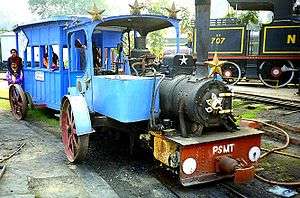
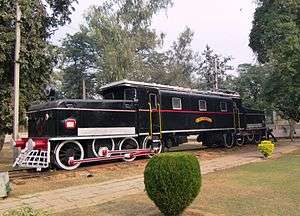
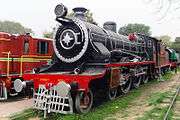
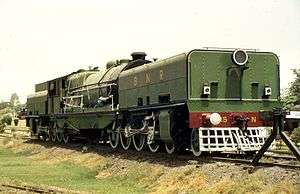
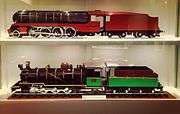
See also
References
- ↑ "Museum History". National Rail Museum. Retrieved 4 July 2017.
- ↑ LTD., C. C. Engineers PVT. "NATIONAL RAIL MUSEUM". nrmindia.com. Retrieved 2018-09-22.
- ↑ Patiala State Monorail Tramway
External links
| Wikimedia Commons has media related to National Rail Museum, New Delhi. |
- Official Museum Website
- Article on National Rail Museum, Delhi by Rangan Datta
- An Enthusiasts site
- Photographic tour
Coordinates: 28°35′05″N 77°10′53″E / 28.58472°N 77.18139°E